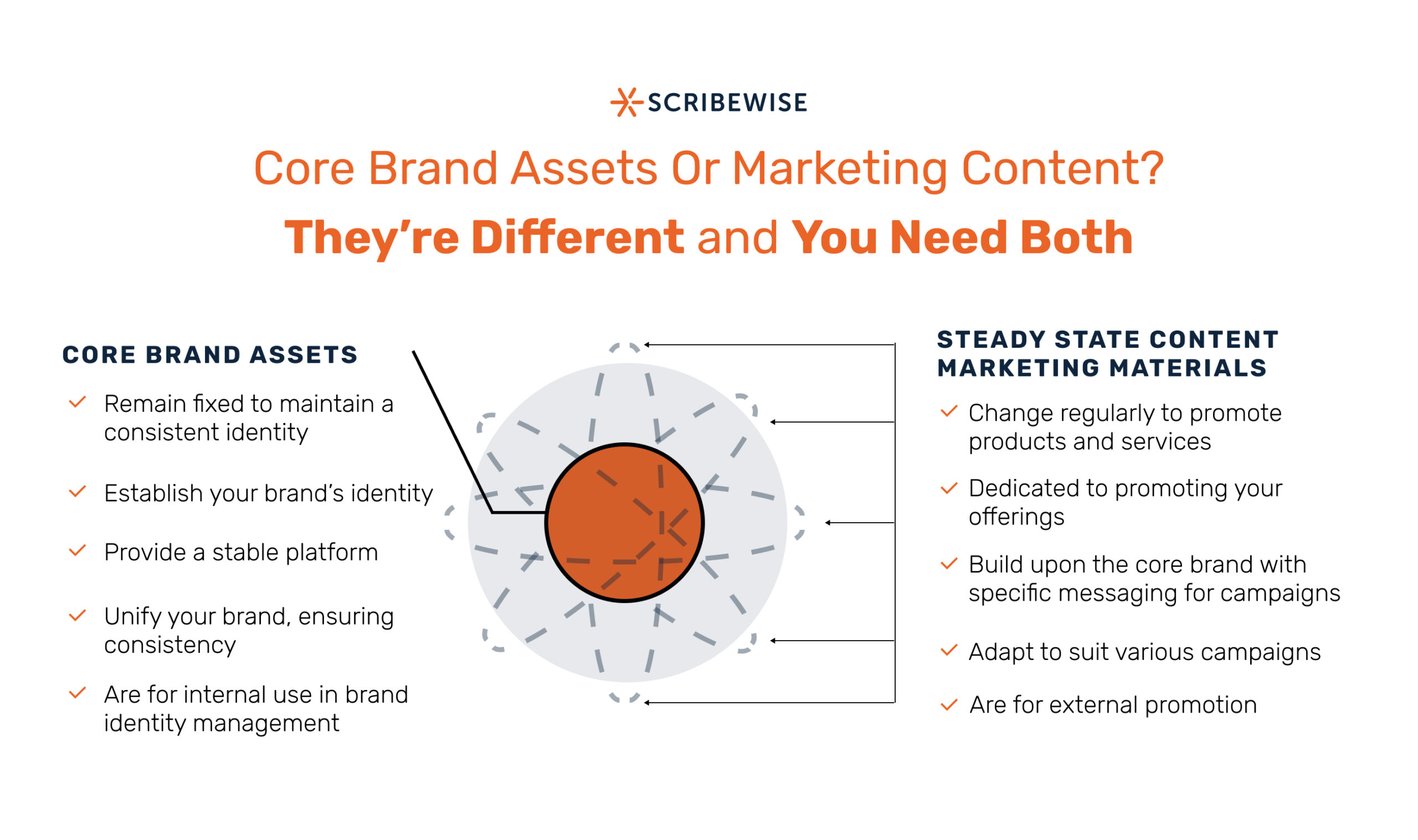If you’re a B2B marketer, you understand the role a solid content marketing program plays within your overall business strategy.
But one does not just … start marketing … without a robust foundation of branded assets that work together to define your business and deepen your differentiators.
Core brand assets (CBAs) are the cornerstone of your brand identity. There’s a difference between CBAs and what we’ll call “steady state marketing content.” Steady state marketing content is always flowing, and changes based on campaigns and initiatives. CBAs, on the other hand, are your brand’s fundamental visual and messaging elements that remain consistent over time. These assets include:
- Logo
- Tagline
- Typography
- Color Palette
- Imagery
- Tone of Voice
- Website
It’s also important to note that core brand collateral (stationery, brochures, presentations, sales sheets and other documents containing visual assets and content) can be (but aren’t always) included in your CBAs.
Core Brand Assets are Evergreen
CBAs should remain consistent over time because they are what your customers recognize and associate with your brand. They provide a solid foundation for developing marketing content, ensuring your messaging is coherent and instantly recognizable.Yes, they may evolve as your brand does, but for the most part should remain consistent in general, everyday use.
Core Brand Assets are Versatile
Here are some real-world instances of how CBAs can be used:
- Letterhead, envelopes and business cards featuring your logo and brand colors
- A PowerPoint presentation template with your brand fonts, colors and imagery
- Printed sales sheets with your tagline, brand colors and stock photos
- A solutions brochure that uses branded fonts, colors, imagery and messaging

Best Practices for Developing Core Brand Assets that will Position Your Brand for Viability and Growth
Following these steps will ensure your brand is set up in a way that empowers and enhances your marketing and sales teams’ efforts and initiative. Skip steps at your own risk!
1. Audit Current Brand Identity and Collateral
Evaluate what’s working and what’s not. Take a deep dive into your existing brand materials to assess their current state.
2. Define Target Audience and Brand Positioning
Clearly identify who your brand is targeting and its position in the market. Be as specific as possible. Thoroughly understand how your product or service cures the pains of this audience.
3. Conduct Market Research
Analyze competitors and industry trends. How is your product or service different?
4. Facilitate Branding Workshops
Collaborate with key stakeholders to define your brand character, personality and values. Getting buy-in from your organization’s leaders is imperative right from the start. Importantly, you should include key voices from your company, but recognize that too many voices can water down your brand—don’t try to please everybody.
5. Design Core Brand Assets
This includes logos, submarks, typography, color palette, imagery and branded collateral.
6. Create a Style Guide
Develop a guide that defines visual identity and usage rules. Be sure internal groups other than marketing will find it easy to understand and use.
7. Finalize Official Brand Guidelines
Share these guidelines internally for consistent implementation.
8. Build Out a Full Suite of Core Brand Assets and Templates
Create all necessary materials for your brand. This includes items such as a logo file library, presentation templates, printed stationery, a website, solutions or capabilities brochures and sales sheets. CBAs and core content include any materials you may use on the regular to define and differentiate your core offering.
9. Train Your Organization
This often-ignored step is essential for brand awareness, consistency and reputation. Ensure that everyone in your organization knows how to implement the assets correctly and provide them with easy-to-access tools to do so.
Finally, You’ll Have all the Tools you Need to Start Marketing.
Inevitably, your brand will evolve, and your CBAs should follow suit. For example, has there been a merger or acquisition? Have you added or removed a product or service? Has the mission changed? Have you narrowed your core audience? All of these reasons justify a change in your brand.
Remember, the most successful marketing programs use their core brand assets to their advantage. Once they’re developed, it should be easy to implement new marketing materials and enjoy the results of a robust and successful content marketing program.

